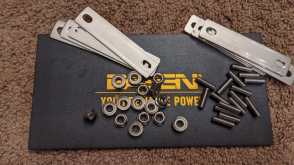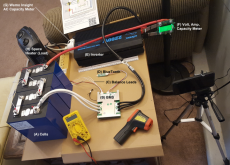Inq720
Odysseus, expert on the Siren's call
Trying to be as thorough as possible, I've Top Balanced and Capacity Tested my first battery build.
I received the cells on 2/11/21. My cells did not come as consecutive numbered items (see table below). I'm assuming this is a sign that they were hand-selected as being similar to each other as all other parameters where identical on the stickers.

Many who purchased 272 Ah cells in the same time frame as I received cells labeled as 280 Ah cells. My cells arrived with better hardware - studs and serrated nuts.

Here is the setup for the capacity test.

Here are my list of cells, and voltages out-of-the-box, after Top Balancing and after shut-off of the Overkill Solar BMS with default settings.

After setting up for the capacity test, I drained the batteries to the normal 100% capacity value of 13.3 volts from the Top Balance value of 14.5 volts. Since there is very little energy in this area of the curve, it didn't take long. 3.9 Amp-hours were drained. The capacity meter was reset. I was able to find a combination of loads that gave me 0.2C or 54.4 amps via a Giandel 2200 watt and a space heater and several incandescent and LED lights.
The test ran till the BMS kicked out. The results are:
275.2 amp-hours
3513.4 watt-hours
5:06:18 of time
I'd say that's pretty close to a 0.2C test as I'll ever be able to do again!
Would anyone have any issues with the variability of the voltages in the chart above? Thanks.
I received the cells on 2/11/21. My cells did not come as consecutive numbered items (see table below). I'm assuming this is a sign that they were hand-selected as being similar to each other as all other parameters where identical on the stickers.

Many who purchased 272 Ah cells in the same time frame as I received cells labeled as 280 Ah cells. My cells arrived with better hardware - studs and serrated nuts.

Here is the setup for the capacity test.

Here are my list of cells, and voltages out-of-the-box, after Top Balancing and after shut-off of the Overkill Solar BMS with default settings.

After setting up for the capacity test, I drained the batteries to the normal 100% capacity value of 13.3 volts from the Top Balance value of 14.5 volts. Since there is very little energy in this area of the curve, it didn't take long. 3.9 Amp-hours were drained. The capacity meter was reset. I was able to find a combination of loads that gave me 0.2C or 54.4 amps via a Giandel 2200 watt and a space heater and several incandescent and LED lights.
The test ran till the BMS kicked out. The results are:
275.2 amp-hours
3513.4 watt-hours
5:06:18 of time
I'd say that's pretty close to a 0.2C test as I'll ever be able to do again!
Would anyone have any issues with the variability of the voltages in the chart above? Thanks.
Last edited:




